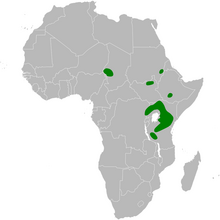White-tailed Lark
| White-tailed Lark | ||||||||||||
|---|---|---|---|---|---|---|---|---|---|---|---|---|

White-tailed Lark |
||||||||||||
| Systematics | ||||||||||||
|
||||||||||||
| Scientific name | ||||||||||||
| Mirafra albicauda | ||||||||||||
| Reichenow , 1891 |
The white-tailed lark ( Mirafra albicauda ) is a species from the lark family. Their distribution area is in Africa. There are two subspecies.
The IUCN currently classifies the stock situation of the white-tailed lark as harmless ( least concern ).
features
The white-tailed lark is significantly smaller and shorter-tailed than a skylark . It also has a stronger beak in comparison to it. The body length is between 13 and 14 centimeters, of which 4.3 to 5 centimeters are on the tail. The beak has a length of 1.2 to 1.3 centimeters.
The top of the body of the white-tailed lark is blackish with gray and brown stripes. The chin and throat are white, the rest of the underside of the body is light yellow-brown. The goiter and chest have umbra brown spots. The wings are brown, the individual feathers are lined with reddish. The middle pair of control feathers is brown with pale pigs. The second and third pair of control springs are brown-washed, with the fourth control springs the outer vane is white, while the inner vane is black-brown. The two outer pairs of control springs, on the other hand, are completely white. The upper beak is dark horn-colored, the lower beak, on the other hand, has a noticeably lighter tone. The feet are brownish, the iris is brown.
The white-tailed lark usually sings its song while singing. It is a melodious chattering song that is without trills. Typical of the white-tailed lark are also rattling, rattling or drumming instrument sounds that are generated with the wings. White-tailed larks soar about 30 meters into the air to perform their singing flight. The singing flight ends with a steep fall back to earth,
Possible confusion
The white-tailed lark shows similarities with the bush lark , whose large range partially overlaps with the white-tailed lark. The white-tailed lark differs from this one by the darker upper side of the body and the two outer white tail feathers. The song of the bush lark also has trills that are missing in the white-tailed lark. The white-tailed lark also only walks a few steps, unlike the bush lark, after it has dropped back to earth from its song flight.
Distribution area and habitat
The white-tailed lark occurs in several isolated populations on the African continent and is a resident bird .
The range includes the west of Kenya and central Kenya. It also populates Uganda, Tanzania, northeast Zaire, east Sudan and west Chad.
The habitat is open steppe-like landscapes with predominantly darker soils, from which the white-tailed lark is well camouflaged. Harlequin quails are often found in the respective habitat of the white-tailed lark . The white-tailed lark is common in parts of its range. In Kenya it occurs at altitudes between 600 and 2000 meters. But it can also be found in the lower plains of Turkana .
Way of life
The white-tailed lark eats seeds, insects and green plant material. The reproductive biology of this species has not yet been conclusively investigated. White-tailed larks in breeding mood were observed in Kenya in March, in Sudan and Tanzania in May.
Like all larks, the white-tailed lark is a ground breeder. The bowl-shaped nest is built in a scratched, shallow hollow. It is either open or arched by grass and is more often found in damp places and in numerous nests, mud has been built into the edge of the nest by the larks. The clutch consists of two eggs. These are white-gray with dark brown spots and scribbles.
literature
- Rudolf Pätzold: The larks of the world . Westarp Sciences, Magdeburg 1994, ISBN 3-89432-422-8 .
Web links
- Mirafra albicauda inthe IUCN Red List of Threatened Species 2016.1. Posted by: BirdLife International, 2016. Retrieved January 7, 2017. </
- White-tailed lark singing on Xeno-Canto
